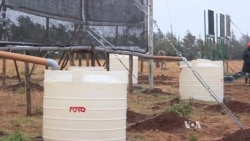The Maasai people of Kenya are known for their cattle-herding, nomadic lifestyle. But it's an existence that depends on access to adequate water for their herds and flocks. In the village of Kiserian, the Maasai community is embracing a new piece of water-harvesting technology with marked results.
In the early morning in Kiserian, a town 30 kilometers from Nairobi, the Lotuno family go about their daily chores - with their matriarch, Hannah, checking on the health of her flock.
"I wake up as early as 5 a.m. to tend to the cattle before they are taken out to pasture," she said." I then check on the sheep's health and I tend to the sickly ones. For them to be productive they need lots of water."
Kiserian is dominated by Maasai cattle herders. During dry spells, they must go far to find enough water and pasture for their animals.
Anthony Purkei is a community organizer who said lack of water is a major issue.
"We experience a lot of problems because we depend on livestock in our livelihood. So when there's drought, our cattle die as a result of there's no water and this area where we live is Kajiado County," he said. "We experience a lot of drought during the year as a result of climate change."
But that problem now has a solution: the fog catcher. Professor Bancy Mati from the Jommo Kenyatta University of Agriculture & Technology developed her variation on the device last year.
The fog collectors look like tall volleyball nets slung between two poles, but they are made of a polypropylene or polyethylene mesh that is especially efficient at capturing water droplets. When the fog rolls in, the tiny droplets of water cling to the mesh, and as more and more cluster together, they drip into a gutter below that channels the water to a water tank.
"Fog is water. But very few people treat it as water because fog is a cloud that is touching the ground and is small droplets of water," Mati said. "The need to collect fog is because fog season follows the rainy season. The foggy season -- that water, instead of letting it go to waste, it is possible to do equipment which will collect fog and the good news is that same equipment collects rain water quite well."
Daniel Lotuno's fog collector was installed on his homestead in April. He said he does not regret spending the $850 for it.
"When there's fog, or some rain, there's some water that we collect,' her said. "Definitely this shows that we get some water because when it was raining or there's fog we still have to go to our fetching areas. But now since there's a fog collection, then we have water."
And for the Lotunos and other Kiserian families, that water -- captured by this revolutionary device -- is making a major impact on daily life.











